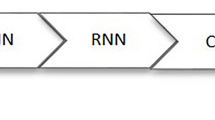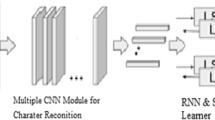Abstract
Most recently, Transformers – which are recurrent-free neural network architectures – achieved tremendous performances on various Natural Language Processing (NLP) tasks. Since Transformers represent a traditional Sequence-To-Sequence (S2S)-approach they can be used for several different tasks such as Handwritten Text Recognition (HTR). In this paper, we propose a bidirectional Transformer architecture for line-based HTR that is composed of a Convolutional Neural Network (CNN) for feature extraction and a Transformer-based encoder/decoder, whereby the decoding is performed in reading-order direction and reversed. A voter combines the two predicted sequences to obtain a single result. Our network performed worse compared to a traditional Connectionist Temporal Classification (CTC) approach on the IAM-dataset but reduced the state-of-the-art of Transformers-based approaches by about 25% without using additional data. On a significantly larger dataset, the proposed Transformer significantly outperformed our reference model by about 26%. In an error analysis, we show that the Transformer is able to learn a strong language model which explains why a larger training dataset is required to outperform traditional approaches and discuss why Transformers should be used with caution for HTR due to several shortcomings such as repetitions in the text.
Access this chapter
Tax calculation will be finalised at checkout
Purchases are for personal use only
Similar content being viewed by others
Notes
- 1.
- 2.
- 3.
Note, this behaviour can easily produced, e.g., in Google-translate by translating repeated words (without line breaks). Translating 16 times the German word “Mann” results in 17 repetitions of the English translation “man” (as of 01/11/2021).
References
Al Azawi, M., Liwicki, M., Breuel, T.M.: Combination of multiple aligned recognition outputs using WFST and LSTM. In: 2015 13th International Conference on Document Analysis and Recognition (ICDAR), pp. 31–35. IEEE (2015)
Al-Sabahi, K., Zuping, Z., Kang, Y.: Bidirectional attentional encoder-decoder model and bidirectional beam search for abstractive summarization. arXiv preprint arXiv:1809.06662 (2018)
Bahdanau, D., Cho, K., Bengio, Y.: Neural machine translation by jointly learning to align and translate. CoRR abs/1409.0473 (2014)
Beltagy, I., Peters, M.E., Cohan, A.: Longformer: the long-document transformer. arXiv preprint arXiv:2004.05150 (2020)
Boschetti, F., Romanello, M., Babeu, A., Bamman, D., Crane, G.: Improving OCR accuracy for classical critical editions. In: Agosti, M., Borbinha, J., Kapidakis, S., Papatheodorou, C., Tsakonas, G. (eds.) ECDL 2009. LNCS, vol. 5714, pp. 156–167. Springer, Heidelberg (2009). https://doi.org/10.1007/978-3-642-04346-8_17
Breuel, T.: High performance text recognition using a hybrid convolutional-LSTM implementation. In: 14th IAPR International Conference on Document Analysis and Recognition (ICDAR), pp. 11–16. IEEE (2017)
Cho, K., Courville, A., Bengio, Y.: Describing multimedia content using attention-based encoder-decoder networks. IEEE Trans. Multimed. 17, 1875–1886 (2015). https://doi.org/10.1109/TMM.2015.2477044
Doetsch, P., Zeyer, A., Ney, H.: Bidirectional decoder networks for attention-based end-to-end offline handwriting recognition. In: 2016 15th International Conference on Frontiers in Handwriting Recognition (ICFHR), pp. 361–366. IEEE (2016)
Dutta, K., Krishnan, P., Mathew, M., Jawahar, C.: Improving CNN-RNN hybrid networks for handwriting recognition. In: 2018 16th International Conference on Frontiers in Handwriting Recognition (ICFHR), pp. 80–85. IEEE (2018)
Graves, A., Fernández, S., Schmidhuber, J.: Multi-dimensional recurrent neural networks. CoRR abs/0705.2011 (2007)
Kang, L., Riba, P., Rusiñol, M., Fornés, A., Villegas, M.: Pay attention to what you read: non-recurrent handwritten text-line recognition. arXiv preprint arXiv:2005.13044 (2020)
Lopresti, D., Zhou, J.: Using consensus sequence voting to correct OCR errors. Comput. Vis. Image Underst. 67(1), 39–47 (1997)
Maas, A.L., Hannun, A.Y., Ng, A.Y.: Rectifier nonlinearities improve neural network acoustic models. In: ICML (2013)
Marti, U.V., Bunke, H.: The IAM-database: an English sentence database for offline handwriting recognition. Int. J. Doc. Anal. Recognit. 5(1), 39–46 (2002)
Michael, J., Labahn, R., Grüning, T., Zöllner, J.: Evaluating sequence-to-sequence models for handwritten text recognition. In: 2019 International Conference on Document Analysis and Recognition (ICDAR), pp. 1286–1293. IEEE (2019)
Pham, V., Kermorvant, C., Louradour, J.: Dropout improves recurrent neural networks for handwriting recognition. CoRR abs/1312.4569 (2013)
Puigcerver, J.: Are multidimensional recurrent layers really necessary for handwritten text recognition?. In: 2017 14th IAPR International Conference on Document Analysis and Recognition (ICDAR), vol. 1, pp. 67–72. IEEE (2017)
Reul, C., Springmann, U., Wick, C., Puppe, F.: Improving OCR accuracy on early printed books by utilizing cross fold training and voting. In: 2018 13th IAPR International Workshop on Document Analysis Systems (DAS), pp. 423–428 (2018)
Rice, S.V., Kanai, J., Nartker, T.A.: An algorithm for matching OCR-generated text strings. Int. J. Pattern Recognit. Artif. Intell. 8(05), 1259–1268 (1994)
Shaw, P., Uszkoreit, J., Vaswani, A.: Self-attention with relative position representations. arXiv preprint arXiv:1803.02155 (2018)
Sutskever, I., Vinyals, O., Le, Q.V.: Sequence to sequence learning with neural networks. In: NIPS (September 2014)
Tensmeyer, C., Wigington, C., Davis, B., Stewart, S., Martinez, T., Barrett, W.: Language model supervision for handwriting recognition model adaptation. In: 16th International Conference on Frontiers in Handwriting Recognition, pp. 133–138. IEEE (2018)
Vaswani, A., et al.: Attention is all you need. In: Advances in Neural Information Processing Systems, pp. 5998–6008 (2017)
Voigtlaender, P., Doetsch, P., Ney, H.: Handwriting recognition with large multidimensional long short-term memory recurrent neural networks. In: ICFHR, pp. 228–233 (October 2016)
Wemhoener, D., Yalniz, I.Z., Manmatha, R.: Creating an improved version using noisy OCR from multiple editions. In: 2013 12th International Conference on Document Analysis and Recognition (ICDAR), pp. 160–164. IEEE (2013)
Wick, C., Reul, C., Puppe, F.: Calamari - a high-performance tensorflow-based deep learning package for optical character recognition. Digit. Humanit. Q. 14(2) (2020)
Wigington, C., Stewart, S., Davis, B., Barrett, B., Price, B., Cohen, S.: Data augmentation for recognition of handwritten words and lines using a CNN-LSTM network. In: ICDAR, pp. 639–645 (November 2017)
Yousef, M., Hussain, K.F., Mohammed, U.S.: Accurate, data-efficient, unconstrained text recognition with convolutional neural networks. Pattern Recognit. 108, 107482 (2020)
Acknowledgments
This work was partially funded by the European Social Fund (ESF) and the Ministry of Education, Science and Culture of Mecklenburg-Western Pomerania (Germany) within the project Neural Extraction of Information, Structure and Symmetry in Images (NEISS) under grant no ESF/14-BM-A55-0006/19.
Author information
Authors and Affiliations
Corresponding author
Editor information
Editors and Affiliations
Rights and permissions
Copyright information
© 2021 Springer Nature Switzerland AG
About this paper
Cite this paper
Wick, C., Zöllner, J., Grüning, T. (2021). Transformer for Handwritten Text Recognition Using Bidirectional Post-decoding. In: Lladós, J., Lopresti, D., Uchida, S. (eds) Document Analysis and Recognition – ICDAR 2021. ICDAR 2021. Lecture Notes in Computer Science(), vol 12823. Springer, Cham. https://doi.org/10.1007/978-3-030-86334-0_8
Download citation
DOI: https://doi.org/10.1007/978-3-030-86334-0_8
Published:
Publisher Name: Springer, Cham
Print ISBN: 978-3-030-86333-3
Online ISBN: 978-3-030-86334-0
eBook Packages: Computer ScienceComputer Science (R0)





